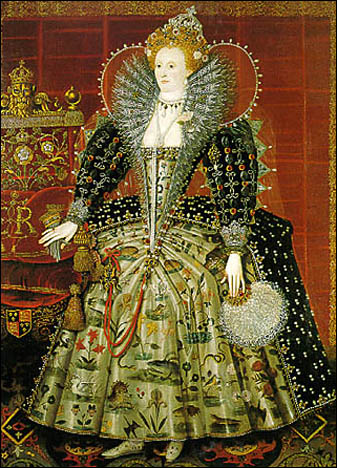 In honor of William Shakespeare we are celebrating the 400th anniversary of his death on April 23, 2016. What better way to do this, than by highlighting the writing done by first-year students in Associate Professor of English John Wesley’s first-year seminar, A Year in the Life of William Shakespeare? This first-year seminar in scholarly inquiry studies four remarkable plays Shakespeare wrote or saw into production in 1599, the same year he opened the Globe Theatre. In the first half of the course, students were introduced to the myriad ways in which Shakespeare’s 1599 plays are shaped by and give shape to the political and cultural intrigues of that year. In the second half of the course, students turned to a play (and year) of their own choosing, the historicist analysis of which is the basis of an independent research project. As part of this project, students were asked to prepare a blog post that reflected on aspects of Shakespeare’s life, a specific work, or a resource or organization associated with Shakespeare, or to provide a personal interpretation of a play. During the month of April, we’ll feature the posts from students that celebrate all things Shakespeare!
In honor of William Shakespeare we are celebrating the 400th anniversary of his death on April 23, 2016. What better way to do this, than by highlighting the writing done by first-year students in Associate Professor of English John Wesley’s first-year seminar, A Year in the Life of William Shakespeare? This first-year seminar in scholarly inquiry studies four remarkable plays Shakespeare wrote or saw into production in 1599, the same year he opened the Globe Theatre. In the first half of the course, students were introduced to the myriad ways in which Shakespeare’s 1599 plays are shaped by and give shape to the political and cultural intrigues of that year. In the second half of the course, students turned to a play (and year) of their own choosing, the historicist analysis of which is the basis of an independent research project. As part of this project, students were asked to prepare a blog post that reflected on aspects of Shakespeare’s life, a specific work, or a resource or organization associated with Shakespeare, or to provide a personal interpretation of a play. During the month of April, we’ll feature the posts from students that celebrate all things Shakespeare!
Congratulations to our wonderful first-year writers. For additional online resources about Shakespeare, check out these sites:
- British Library: http://www.bl.uk/
- Folger Shakespeare Library: http://www.folger.edu/
- Globe Theatre: http://www.shakespearesglobe.com
- Internet Shakespeare Editions: http://internetshakespeare.uvic.ca
- Shakespeare 400: http://www.shakespeare400.org/
Shakespearean Fashion
By Anna Mullins
Fashion has always played an important part in our lives, but we tend to take it for granted. Today, we usually just throw something quick and comfortable on. People during Shakespeare’s time were not always free to wear whatever they felt like and there were very strict societal rules and even laws governing what you were allowed to wear and when you could wear it.
“The reign of Queen Elizabeth marks an era of unprecedented activity in the history of restraints on apparel” (Hooper). Queen Elizabeth was very fond of outward uniformity and etiquette and this showed in her attempt to regulate a quickly growing and changing populace. She even went as far as assigning two “watchers”, men who were spies for Queen Elizabeth, for every parish to make sure that all citizens obeyed the new law. Even in the presence of constant and overbearing regulations fashion still managed to thrive and change as quickly as it does today. It’s hard to imagine that a woman so strict in her views on what others could wear would have such a passion for fashion but Elizabeth had a large amount of clothing. It has been noted that, “Elizabeth I spent large amounts on clothes and jewelry both for herself and as marks of favor,” and had “six thousand dresses and it was found that art could not devise anything more costly and gorgeous” (Jones and Stallybrass). From the information we have, we can tell that fashion and garments were a significant part of the lives of the citizens of Elizabethan England.
One question you might have is: “But what does all this have to do with Shakespeare and his plays?” Well, it has everything to do with Shakespearean theater. Clothing was vital for the stage because all of the players were biologically male. This is very different from the way things are today but was the norm for many, many centuries as it was seen as indecent for a woman to be an actor. The first thing the audience would see, that would define a character would be the clothing worn by the actor. During this time period, women’s clothing significantly established the shape of the wearer due to the rigid form of the bodice. Women of this time wore many layers with very little skin showing, so for a male actor and one who was most likely prepubescent it would not have been difficult to pass as a woman on the stage because the only part of his body showing would have been his face. Clothing did more on the stage than tell the audience the sex of the character, it also materially constructed the masculinity or femininity of the intended gender because the dress during this time was so rigidly gendered. There was no ambivalence as to whether or not a specific article was male or female like there is today. The clothing also established the actions that the person could not or should not pursue. For example, when Olivia wore men’s trousers in “The Twelfth Night”.
In our fast paced and hectic lives many of us don’t get to take the time to dress how we would like and don’t get the opportunity to express ourselves through fashion any more. It wasn’t always this way and it doesn’t have to remain this way. Let’s bring back the importance fashion once held and wear our clothing with pride.
Bibliography
Hooper, Wilfrid. “The Tudor Sumptuary Laws.” The English Historical Review (1915): 433-449.
Jones, Ann Rosalind and Peter Stallybrass. Renaissance Clothing and the Materials of Memory. Cambridge: University of Cambridge, 2000.
Portrait: http://www.elizabethanenglandlife.com/

